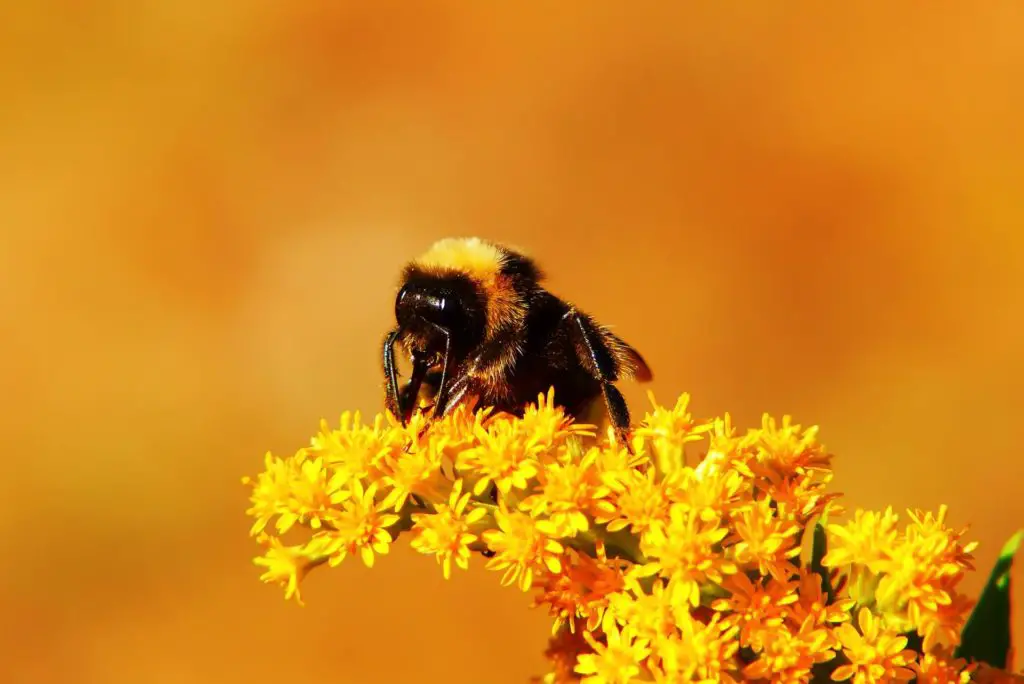Last updated on October 5th, 2023 at 10:43 pm
The early bumblebee sometimes referred to as the early-nesting bumblebee, Latin name Bombus pratorum is a widely spread species visible in many areas across the UK.
This relatively small species of bumblebee gains its name for being one of the first bumblebees to appear in early spring, feasting on early blooming flower varieties.
What do early bumblebees look like?
The early bumblebee is characterised by an orange/ginger tail. Both males and workers can display a yellow band across the abdomen but this can be barely visible in female specimens of the species.
Males of the species will often display considerable yellow hairs across the abdomen and facial area alongside their distinctive yellow band.
How big are early bumblebees?
The easiest way to differentiate between the different early bumblebee sexes is by their size.
- Queen – 1.5cm – 1.7cm
- Worker – 1cm – 1.4cm
- Male – 1.1cm – 1.3cm
In comparison to other bees, the early bumblebee is just slightly smaller than the common carder bee.
Early bumblebee queens
Queens of the species are always slightly larger than the workers in size. Unlike honeybee queens, the early bumblebee queen uses signs and displays of aggression to ensure obedience from workers within the nest.
Queens are tasked with identifying a new nest site and starting the colony. The queen is the only bee in the nest capable of producing more virgin queens to continue her lineage.
These queens will grow to adulthood in the nest before taking flight to mate and find their own sites to begin a new nest.
Workers
Like all bees, workers of the species are always female. Newly matured workers can be ready to forage in as little as two to three days. This means that new nests become quickly self-sufficient allowing the queen to focus on laying eggs and increasing the colony’s population.
Some workers within the nest never grow or mature to a stage where they can fly and are characterised by small wings, weak legs and less worn hairs on the abdomen due to the lack of flying and foraging.
Males
Males indicate that the colony is nearing the end of its life cycle. When the current queen senses her time coming to an end she will start to produce males that will seek out virgin queens to mate with.
Sadly once these males have mated they have served their purpose and will expire as the weather becomes colder and suitable food sources decline rapidly.
The taxonomy of early bumblebees
Early bumblebees are members of the genus Bombus and the subgenus Pyrobombus. Like most other members of the Bombus family, they display monandrous mating behaviours.
This simply means that unlike other bee species like honeybees an Early bumblebee female will mate with a single bee and store that sperm for the rest of her lifespan.
Behaviour
The most distinctive behaviour is their preference for emerging very early on in Spring, sometimes as early as February in the United Kingdom. Due to their relatively short lifespan of approximately 14 weeks, the nests they create are occupied for far less time than most other bumblebee species.
In one summer early bumblebees can produce up to two generations with each nest containing between 50-150 bees.
Interestingly, the workers within a nest may start to lay eggs at approximately the same time a queen starts to produce male eggs. Workers can only ever produce male worker bees but this process can cause significant conflict within the colony.
Workers’ behaviour starts to change as they lay their own eggs with aggressive tendencies similar to that of the queen. In extreme cases, workers may even try to eat eggs laid by other workers or even the queen.
Early bumblebee diet
Early bumblebees are adept pollinators but unlike other bumblebee species, they are somewhat selective with the plants and flowers they choose to visit.
Opting primarily for varieties of the Fabaceae or Leguminosae families commonly known as the bean, pea or legume family.
Some of their most visited species include:
- Sage
- Lavender
- White clover
- Cotoneaster
- Thistle
- Allium
Check them out in action in the video below.





